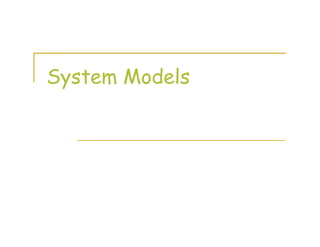The document discusses various models for distributed systems including architectural, interaction, failure, software layer, and process models. It describes key aspects of distributed systems like client-server, peer-to-peer, and mobile code architectures. Requirements for distributed designs like performance, quality of service, caching, and dependability are covered. Fundamental models for message passing between processes are defined including states, configurations, computation and delivery events.



















![Formal Model of Message-Passing Systems
There are n processes in the
system: p0, .., pn-1
Each process is modeled as
a state machine.
The state of each process is
comprised by its local variables and a set of arrays.
For instance, for p0, the state includes six arrays:
inbuf0[1], …, inbuf0[3]: contain messages that have been
sent to p0 by p1, p2 and p3, respectively, but p0 has not yet
processed.
outbuf0[1], …, outbuf0[3]: messages that have been sent by
p0 to p1, p2, and p3, respectively, but have not yet been
delivered to them.](https://image.slidesharecdn.com/cs556-section2-140529142202-phpapp02/85/Cs556-section2-20-320.jpg)
![Formal Model of Message-Passing Systems
The state of process pi excluding the outbufi[l]
components, comprises the accessible state of pi.
Each process has an initial state in which all inbuf
arrays are empty.
At each step of a process, all messages stored in
the inbuf arrays of the process are processed, the
state of the process changes and a message to each
other neighboring process can be sent.
A configuration is a vector C = (q0, .., qn-1) where qi
represents the state of pi.
The states of the outbuf variables in a configuration
represent the messages that are in transit on the
communication channels.
In an initial configuration all processes are in initial states.](https://image.slidesharecdn.com/cs556-section2-140529142202-phpapp02/85/Cs556-section2-21-320.jpg)








